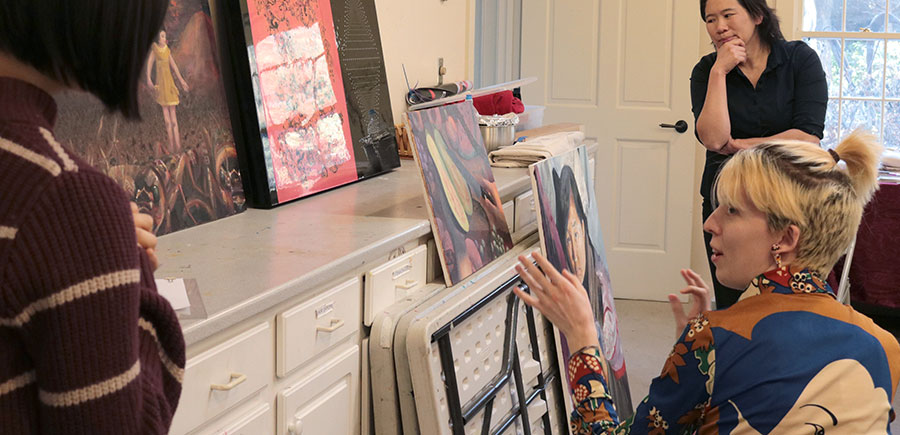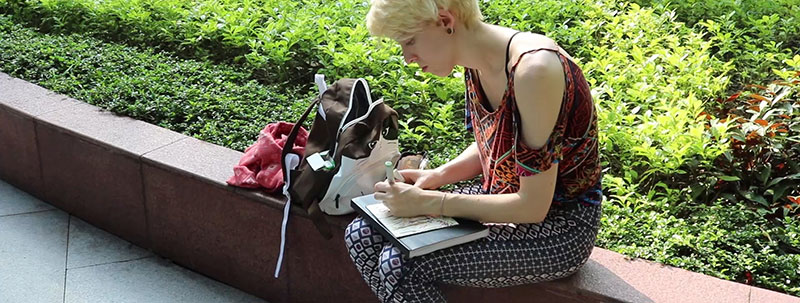Prompt

Self-critique the current state of your portfolio and create a plan of action for how you will develop your portfolio.
Weed out class assignments
Any artworks that are obviously assignments from a class should be removed: sketches of a nude model posing in class, color exercises, a still life that an instructor set up for you to paint in class, a linear perspective exercise, etc.

Write a checklist of portfolio goals
What are qualities that you want the artwork in your portfolio to have? Do you want your artwork to have an emotional impact on the viewer? Is your artwork intended to address current events or social issues?
Do you want your artwork to be quiet and contemplative, or epic and comedic?

Determine art media
There is no requirement that an MFA Portfolio be focused on 1 specific art medium.
However, determining what art medium you want to work with on a more sustained basis can provide focus and cohesion to your portfolio that is tough to maintain if you are jumping all over the place with your art media.

Reference 2 contemporary artists
Find 2 contemporary artists whose work is similar to yours. Perhaps you are a figurative oil painter, in which case you may consider looking at Jordan Casteel, John Currin, and Jerrell Gibbs.
Be sure to search for artists outside of Instagram, check our artists lists and art publications where you can find a broader range of artists.

Write down specifics of how these artists engage with contemporary life, new developments in technology, are they discussing political topics, is their artwork a commentary on a specific culture or community?

Reference 2 historical artists

Find 2 artists before the 20th century whose work you engage with.
These 2 historical artists don’t necessarily have to be working in the same art medium and genre, in fact, their artwork could be totally different to your own studio practice.

Watch our video on how to start learning art history to get going.

Write down what qualities of these artists interest you, is it the way their reacted to the current events of their time period, their culture? What are the visual aspects of their artwork that you find intriguing?

Set a goal based on a prior artwork
Choose an artwork in your portfolio that is a reflection of the direction you want to take in developing your portfolio.
Perhaps the artwork has a more abstract style that you want to focus on more, or the subject matter is one you are starting to dig into.

Identify your tendencies
Are there any aspects of your studio practice that you fall into automatically, that perhaps you want to get rid of, or be more conscious of?

This could be a color palette that you tend to work with, a certain brush technique that is common in your paintings, a lack of diversity or representation in your subjects, etc.


How to Prepare an MFA Portfolio
The process of preparing a portfolio for an MFA studio art requires a level of maturity and engagement with critical thinking. At the MFA level, the concerns shift from technical skills to developing a unique artistic vision.
This video explores the challenges and strategies that come with preparing an MFA portfolio. Discussion led by Art Prof Clara Lieu, Yale MFA student Leyla Faye and Hunter College MFA student (and Art Prof Teaching Artist) Lauryn Welch.
How to Self-Critique as an Artist
Learning how to self critique can be a really useful skill for visual artists to have, many people often times don’t have an ongoing source of critical feedback in their artwork that they can access any time they need it.
However, critiquing yourself is often times tough to do, how do you step outside of your own head and evaluate what you’ve just made? How can you get a more objective perspective on your artistic process when you are so deeply immersed in your own creative process?
Art Prof Clara Lieu identifies the difficulties of critiquing your own artwork, and provides specific approaches and exercises you can take to evaluate your own progress by yourself.


